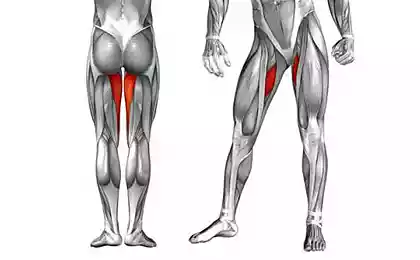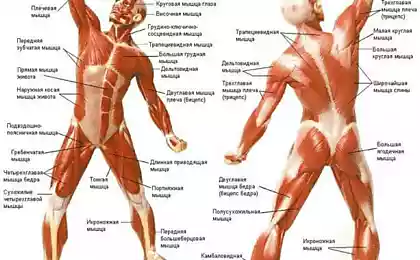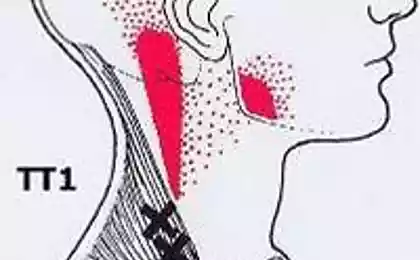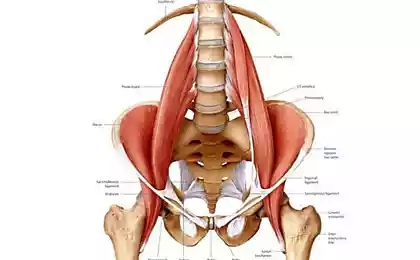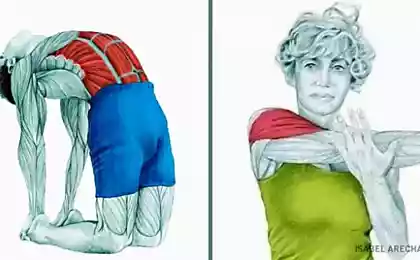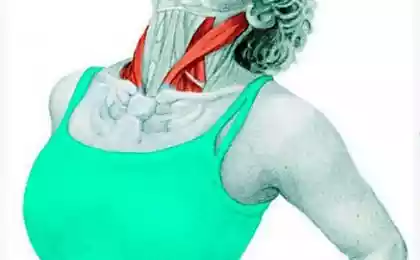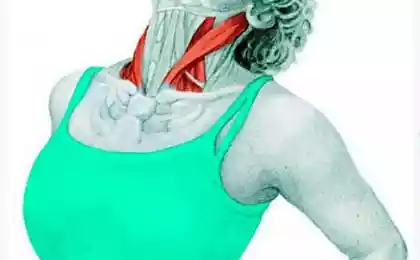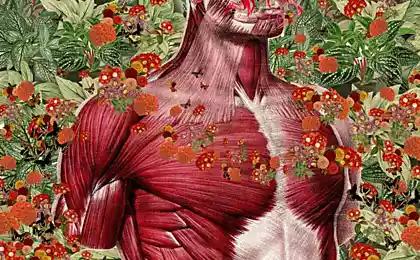310
Psychological Muscle Functions: Learn How Your Personality Is Embedded in Your Muscles
From the idea of the bodily “binding” of certain personal qualities follows a metaphorical idea of the psychological functions of individual muscles. Through the normalization of the state of the muscles, correction of psychological problems can be carried out. Diagnosis of the state of individual muscles can be used to diagnose psychological problems.
In classical psychoanalysis, the strength of the ego is considered an indicator of a person’s mental health, and the purpose of therapy is the education of a mature ego. By analogy with this in Bodynamic analysis introduces the concept of the bodily Ego, the functions of which are:
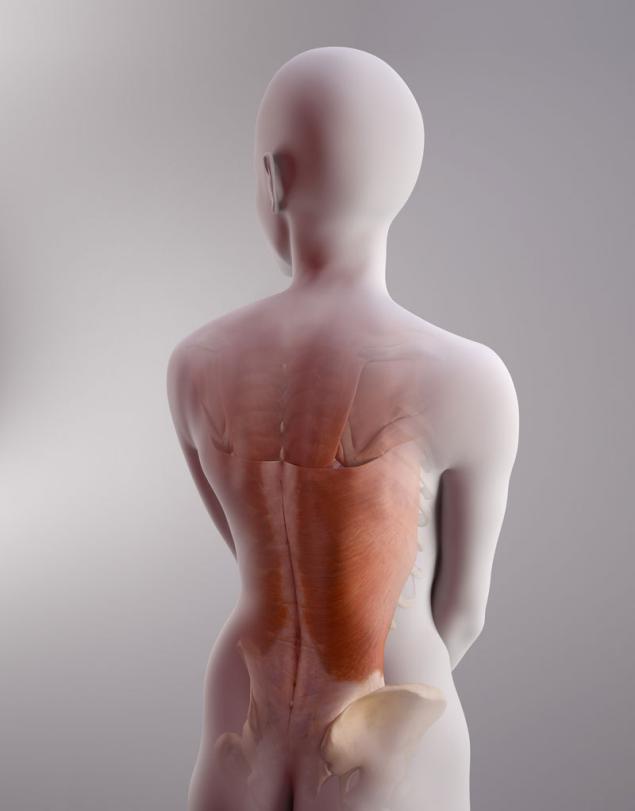
Image by ©James Archer
The mature bodily Ego is a condition of both psychological and socio-psychological adaptation. On its basis, the integrity, unity of a person with himself and with other people is built, which is a reflection of the universal human relationship.
The term "bodynamic" is formed from the merger of two roots: body + change (dynamics).Thus, it can be deciphered as "bodydynamic" analysis or developmental analysis.
The method is based on the concepts of the psychology of age development, anatomy and age-related physiology of the neuromuscular system, describing the dynamics of the child’s bodily development, its parallelism with personal development. Method developed by Danish psychotherapist Lisbeth Marcher(Lisbeth Marcher), a follower of Wilhelm Reich, based on his ideas about the "muscle shell".
From the idea of the corporeality of the ego, of the bodily “binding” of certain personal qualities, a metaphorical idea of the psychological functions of individual muscles follows. or muscle groups that underlie bodily-psychic unity.
If this view is true, the opposite is true: through the normalization of the state of the muscles, correction of psychological problems can be carried out (feedback principle). Diagnosis of the state of individual muscles can be used to diagnose psychological problems.
Marcher came to description of the formation of the structure of character at the bodily level as an integral part of psychomotor developmenteh at the psychological level - as a sequence of alternative elections that naturally develops over time (table 2), personality-building. The particular personal properties corresponding to these most general choices are imprinted in the muscles (see Table 1).
Table 1. Metaphorical psychological functions of muscles according to Marcher.
Muscle groups
Psychological functions of muscles
Head, neck.
Mimic muscles in general
Expression of feelings, social contacts
Muscles around the eyes
Focus and short-term planning
Oral muscles and tongue
Emotional acceptance
Anterior neck muscles
Speech expression
Muscles of the back of the neck
Willpower, pride, orientation in circumstances
Shoulder belt and arms
Extensors and flexors of the shoulder, as well as muscles that lead and withdraw the shoulder
Personal space in relationships
Muscles lifting the shoulder
Ability to carry a psychological “burden”
Shoulder rotators
Self-protection and the ability to receive support from others
Forearm extensors
Repulsion, distance retention
Forearm flexors
Attraction and retention
Forearm rotators
Take and give
Wrist flexors and extensors
Positioning or social control of behavior
Muscles opposing thumb and pinky
Acute perception; written speech
Finger extensors
Subtle adaptation (change of boundaries); the ability to “let go”
Finger flexors
Touch, study and retention; the ability to take and give
Torso
Anterior chest muscles (large and small chest and anterior dentate muscles)
Feelings of self-worth and personal strength (both in superficial and deep contact)
Intercostal muscles (primary respiratory muscles)
Feeling the fullness of being, the “space of breath”
Diaphragm (secondary respiratory muscle); superficial abdominal muscles
Emotional self-control; holding and digesting emotions
Large and small lumbar muscles
Intimate attachment
Torso extensors (spine)
Ability to resist emotional and physical stressors
Square lumbar muscle
Balance between focusing on your own feelings or the emotions of others
Pelvic floor muscles
Sexual feelings
Feet.
Thigh flexors
Initiating forward movement and psychological contact
Hip extensors
Self-affirmation, the ability to “stand your ground”
Hip rotators
Sexually Sensitive Self-Awareness
Muscles leading the hip
Intimate and sensual contacts
Tin extensors
Personal Boundaries in Relationships
Tin flexors
Selecting direction and controlling forward movement
fibula muscle
Personal balance in group interaction
Foot and finger extensors
Contact with reality
Foot flexors
Self-affirmation, the ability to “stand firmly on your feet”
Finger flexors
Feeling of contact with the ground
Bodynamic analysis made significant additions to Reich’s ideas about character structure and “muscle shell”. In bodily psychotherapy, character structure was originally understood as a set of subconscious, irrational stereotypes of behavior in stressful situations - a set that is formed in each person from an early age (it is with the reproduction of childhood experiences and associated elements of irrationality).
At the same time, it develops in many ways spontaneously, under the influence of circumstances (possibly by imitating others). A set of typical psychological defenses is, according to Reich, "character shell", and their reflection in the form of areas of increased muscle tone - "muscle shell".
At the same time, according to Marcher, in the process of development, different muscle groups “mature” at different times.
Psychomotor development is presented as a consistent “maturation” of certain muscles. (and the development of related movements). By “maturing” I mean here. Achieving a degree of neuromuscular maturity that makes the activity of the muscle fully accessible to conscious control.
The transition of the muscle to a “mature” state is associated with a specific age period, and is limited by a rather narrow time frame. It's the so-called critical or sensitive period of developmentIt is also associated with indelible experience gained in the situation of primary learning (imprint).
When a child is faced with traumatic situations, two problems arise. First, a violation of psychomotor development, its partial delay at this age stage (a bodily analogue of Freudian fixation). At first, it is designed to play a protective role, but in the future it becomes a “brake” of further development, the basis of the inferiority complex. Secondly, the resulting imprint usually contains biographical scenes full of traumatic experiences.
Although these memories are repressed, because such protection is not absolute, they create a kind of “Achilles heel”, islands of increased psychological vulnerability in the structure of the personality. The kinesthetic sensations associated with “problem” muscles are partially replaced, they become inaccessible to consciousness.
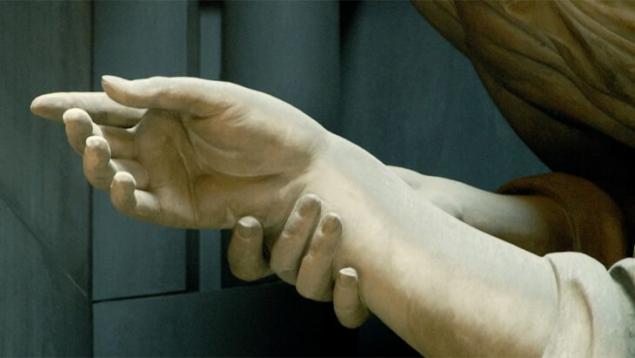
Table 2. Periodization of age-related psychological development by Marcher.
Development segment
Age limits
Psychological content
Existence
Intrauterine period and up to 3 months after birth
Relationship to mother
Need.
1 month to 1.5 years
Internalization of the sense of care from others, satisfaction of needs
Autonomy
8 months to 2.5 years
Independent movement and communication with others
Will
2 to 4 years
Ability to achieve goals and influence others
Love.
3 to 6 years
Ability to maintain heart relationships
Opinion-building
5 to 8 years old
Formation of logical thinking, the ability to make decisions based on cultural norms
Collectivism
7 to 12 years old
Ability to be a member of a group/society
Hence, two tasks of bodily psychotherapy follow.
The tactical task is to identify muscle "blocks"; strategicthe elimination of these “blocks” – development of missing bodily and psychological resources.
The initial stage of work with the patient is a bodily diagnostic procedure - drawing up an individual muscle "map". With this mapping, about 200 muscles are examined.
At the same time, unlike traditional bodily therapy, not only a static, "mechanical" characteristic - muscle tone (that is, the state of the muscle at rest) is analyzed, but also a dynamic characteristic of the state of the muscle. This is the so-called reactivity, that is, the reflex response of the muscle to its mechanical manual stimulation - palpation.
similarThe response of the muscle can be compared with a feedback channel, with a subconscious signal about the acceptability / unacceptability of this bodily contact.. If the muscle tone and its reactivity correspond to the median range on the conventional scale (normal range), then it is considered that this muscle is in a resource state. Otherwise, its condition is regarded as a deviation from the norm - respectively, hypo- or hyperreactivity.
Comparison with the scheme of age-related psychomotor development suggests at what age there were psychotraumatic situations that affected the state of the muscles. Psychological trauma, suffered during a critical period of age development or at an even earlier age, manifests itself in hypotonus (hyporeactivity) of the corresponding muscle. If the psychotrauma took place at an older age, then its result is muscle damage. hypertension (hyperreactivity).
In contrast to the Reich approach, Bodynamic analysis abandons attempts to forcibly remove the "muscle shell"Not to leave the patient defenseless. Instead, It is proposed to teach the patient to be aware of the presence of his own “shell” in various life situations, as a way to control emotions and access internal resources.
Daughters Who Were Disliked and the Burden of Family Secrets
Frozen pain.
Ultimately, along with restoring the resource state of the corresponding muscles, this leads to the strengthening or “awakening” of the bodily Ego.Harmonization of functions of which serves as the main goal of psychocorrective work. published
Author: Mark Sandomiersky
P.S. And remember, just changing our consumption – together we change the world!
Source: www.elitarium.ru/myshcy-pancir-razvitie-harakter-marcher-rajh-sostojanie-analiz-diagnostika-terapija-chuvstvo/
In classical psychoanalysis, the strength of the ego is considered an indicator of a person’s mental health, and the purpose of therapy is the education of a mature ego. By analogy with this in Bodynamic analysis introduces the concept of the bodily Ego, the functions of which are:
- thinking;
- emotional control;
- Life position (beliefs and stereotypes of behavior);
- I balance (the internal psychological balance between I and others, between feelings and reason)
- Approach/Distance (external balance in relationships with people)
- relationships with people around them;
- centering (self-esteem);
- grounding and reality testing;
- Formation of boundaries (assertiveness);
- expression.

Image by ©James Archer
The mature bodily Ego is a condition of both psychological and socio-psychological adaptation. On its basis, the integrity, unity of a person with himself and with other people is built, which is a reflection of the universal human relationship.
The term "bodynamic" is formed from the merger of two roots: body + change (dynamics).Thus, it can be deciphered as "bodydynamic" analysis or developmental analysis.
The method is based on the concepts of the psychology of age development, anatomy and age-related physiology of the neuromuscular system, describing the dynamics of the child’s bodily development, its parallelism with personal development. Method developed by Danish psychotherapist Lisbeth Marcher(Lisbeth Marcher), a follower of Wilhelm Reich, based on his ideas about the "muscle shell".
From the idea of the corporeality of the ego, of the bodily “binding” of certain personal qualities, a metaphorical idea of the psychological functions of individual muscles follows. or muscle groups that underlie bodily-psychic unity.
If this view is true, the opposite is true: through the normalization of the state of the muscles, correction of psychological problems can be carried out (feedback principle). Diagnosis of the state of individual muscles can be used to diagnose psychological problems.
Marcher came to description of the formation of the structure of character at the bodily level as an integral part of psychomotor developmenteh at the psychological level - as a sequence of alternative elections that naturally develops over time (table 2), personality-building. The particular personal properties corresponding to these most general choices are imprinted in the muscles (see Table 1).
Table 1. Metaphorical psychological functions of muscles according to Marcher.
Muscle groups
Psychological functions of muscles
Head, neck.
Mimic muscles in general
Expression of feelings, social contacts
Muscles around the eyes
Focus and short-term planning
Oral muscles and tongue
Emotional acceptance
Anterior neck muscles
Speech expression
Muscles of the back of the neck
Willpower, pride, orientation in circumstances
Shoulder belt and arms
Extensors and flexors of the shoulder, as well as muscles that lead and withdraw the shoulder
Personal space in relationships
Muscles lifting the shoulder
Ability to carry a psychological “burden”
Shoulder rotators
Self-protection and the ability to receive support from others
Forearm extensors
Repulsion, distance retention
Forearm flexors
Attraction and retention
Forearm rotators
Take and give
Wrist flexors and extensors
Positioning or social control of behavior
Muscles opposing thumb and pinky
Acute perception; written speech
Finger extensors
Subtle adaptation (change of boundaries); the ability to “let go”
Finger flexors
Touch, study and retention; the ability to take and give
Torso
Anterior chest muscles (large and small chest and anterior dentate muscles)
Feelings of self-worth and personal strength (both in superficial and deep contact)
Intercostal muscles (primary respiratory muscles)
Feeling the fullness of being, the “space of breath”
Diaphragm (secondary respiratory muscle); superficial abdominal muscles
Emotional self-control; holding and digesting emotions
Large and small lumbar muscles
Intimate attachment
Torso extensors (spine)
Ability to resist emotional and physical stressors
Square lumbar muscle
Balance between focusing on your own feelings or the emotions of others
Pelvic floor muscles
Sexual feelings
Feet.
Thigh flexors
Initiating forward movement and psychological contact
Hip extensors
Self-affirmation, the ability to “stand your ground”
Hip rotators
Sexually Sensitive Self-Awareness
Muscles leading the hip
Intimate and sensual contacts
Tin extensors
Personal Boundaries in Relationships
Tin flexors
Selecting direction and controlling forward movement
fibula muscle
Personal balance in group interaction
Foot and finger extensors
Contact with reality
Foot flexors
Self-affirmation, the ability to “stand firmly on your feet”
Finger flexors
Feeling of contact with the ground
Bodynamic analysis made significant additions to Reich’s ideas about character structure and “muscle shell”. In bodily psychotherapy, character structure was originally understood as a set of subconscious, irrational stereotypes of behavior in stressful situations - a set that is formed in each person from an early age (it is with the reproduction of childhood experiences and associated elements of irrationality).
At the same time, it develops in many ways spontaneously, under the influence of circumstances (possibly by imitating others). A set of typical psychological defenses is, according to Reich, "character shell", and their reflection in the form of areas of increased muscle tone - "muscle shell".
At the same time, according to Marcher, in the process of development, different muscle groups “mature” at different times.
Psychomotor development is presented as a consistent “maturation” of certain muscles. (and the development of related movements). By “maturing” I mean here. Achieving a degree of neuromuscular maturity that makes the activity of the muscle fully accessible to conscious control.
The transition of the muscle to a “mature” state is associated with a specific age period, and is limited by a rather narrow time frame. It's the so-called critical or sensitive period of developmentIt is also associated with indelible experience gained in the situation of primary learning (imprint).
When a child is faced with traumatic situations, two problems arise. First, a violation of psychomotor development, its partial delay at this age stage (a bodily analogue of Freudian fixation). At first, it is designed to play a protective role, but in the future it becomes a “brake” of further development, the basis of the inferiority complex. Secondly, the resulting imprint usually contains biographical scenes full of traumatic experiences.
Although these memories are repressed, because such protection is not absolute, they create a kind of “Achilles heel”, islands of increased psychological vulnerability in the structure of the personality. The kinesthetic sensations associated with “problem” muscles are partially replaced, they become inaccessible to consciousness.

Table 2. Periodization of age-related psychological development by Marcher.
Development segment
Age limits
Psychological content
Existence
Intrauterine period and up to 3 months after birth
Relationship to mother
Need.
1 month to 1.5 years
Internalization of the sense of care from others, satisfaction of needs
Autonomy
8 months to 2.5 years
Independent movement and communication with others
Will
2 to 4 years
Ability to achieve goals and influence others
Love.
3 to 6 years
Ability to maintain heart relationships
Opinion-building
5 to 8 years old
Formation of logical thinking, the ability to make decisions based on cultural norms
Collectivism
7 to 12 years old
Ability to be a member of a group/society
Hence, two tasks of bodily psychotherapy follow.
The tactical task is to identify muscle "blocks"; strategicthe elimination of these “blocks” – development of missing bodily and psychological resources.
The initial stage of work with the patient is a bodily diagnostic procedure - drawing up an individual muscle "map". With this mapping, about 200 muscles are examined.
At the same time, unlike traditional bodily therapy, not only a static, "mechanical" characteristic - muscle tone (that is, the state of the muscle at rest) is analyzed, but also a dynamic characteristic of the state of the muscle. This is the so-called reactivity, that is, the reflex response of the muscle to its mechanical manual stimulation - palpation.
similarThe response of the muscle can be compared with a feedback channel, with a subconscious signal about the acceptability / unacceptability of this bodily contact.. If the muscle tone and its reactivity correspond to the median range on the conventional scale (normal range), then it is considered that this muscle is in a resource state. Otherwise, its condition is regarded as a deviation from the norm - respectively, hypo- or hyperreactivity.
Comparison with the scheme of age-related psychomotor development suggests at what age there were psychotraumatic situations that affected the state of the muscles. Psychological trauma, suffered during a critical period of age development or at an even earlier age, manifests itself in hypotonus (hyporeactivity) of the corresponding muscle. If the psychotrauma took place at an older age, then its result is muscle damage. hypertension (hyperreactivity).
In contrast to the Reich approach, Bodynamic analysis abandons attempts to forcibly remove the "muscle shell"Not to leave the patient defenseless. Instead, It is proposed to teach the patient to be aware of the presence of his own “shell” in various life situations, as a way to control emotions and access internal resources.
Daughters Who Were Disliked and the Burden of Family Secrets
Frozen pain.
Ultimately, along with restoring the resource state of the corresponding muscles, this leads to the strengthening or “awakening” of the bodily Ego.Harmonization of functions of which serves as the main goal of psychocorrective work. published
Author: Mark Sandomiersky
P.S. And remember, just changing our consumption – together we change the world!
Source: www.elitarium.ru/myshcy-pancir-razvitie-harakter-marcher-rajh-sostojanie-analiz-diagnostika-terapija-chuvstvo/


